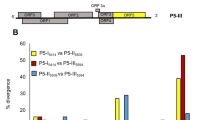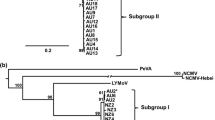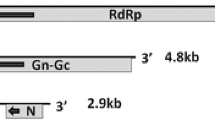Abstract
This is the first report of the genetic diversity within ilarvirus subgroup 1 from eastern Australia. It supports the separation of tobacco streak virus (TSV) strains from parthenium (Parthenium hysterophorus) and crownbeard (Verbescina encelioides) based on serology and host specificity. It has confirmed one previously described strain of TSV as a member of the species Strawberry necrotic shock virus and another as a new subgroup 1 ilarvirus, ageratum latent virus (AgLV), from Ageratum houstonianum. A multiplex RT-PCR showed that the genetically distinct strains of TSV and AgLV were commonly found in symptomless infections in virus-specific alternative weed hosts growing over a wide geographical range in eastern Australia. TSV has been one of the most damaging viruses in Australian oilseed and pulse crops in recent years, and this study has provided the taxonomic knowledge essential for the development of control programs for these viruses.


Similar content being viewed by others
References
King AMQ, Adams MJ, Carstens EB, Lefkowitz EJ (2011) Virus taxonomy: ninth report of the international committee on taxonomy of viruses. Elsevier Academic Press, San Diego
Codoñer FM, Cuevas JM, Sánchez-Navarro JA, Pallás V, Elena SF (2005) Molecular evolution of the plant virus family Bromoviridae based on RNA3-encoded proteins. J Mol Evol 61(5):697–705
Boulila M (2009) Recombination structure and genetic relatedness among members of the family Bromoviridae based on their RNAs 1 and 2 sequence analyses. Virus Genes 38(3):435–444
Codoñer FM, Elena SF (2006) Evolutionary relationships among members of the Bromoviridae deduced from whole proteome analysis. Arch Virol 151(2):299–307
Johnson J (1936) Tobacco streak, a virus disease. Phytopathology 26:285–292
Fulton RW (1967) Purification and some properties of Tobacco streak and Tulare apple mosaic viruses. Virology 32:153–162
ICTV (2011) ICTV Master List 2011. http://talk.ictvonline.org/files/ictv_documents/m/msl/4090.aspx. Accessed 2 July 2012
Maroon-Lango CJ, Aebig J, Hammond J, Hsu HT (2006) Molecular and biological characterization of a novel ilarvirus in bacopa. Phytopathology 96(6):S73
Greber RS (1971) Some characteristics of tobacco streak virus isolates from Queensland. Qld J Agri Anim Sci 28:105–114
Sharman M, Constable F, Perera R, Thomas J (2011) First report of Strawberry necrotic shock virus infecting strawberry (Fragaria vesca) from Australia. Australas Plant Dis Notes 6:54–56. doi:10.1007/s13314-011-0018-6
Greber RS (1979) Virus diseases of Queensland strawberries and the epidemiological effects of the strawberry runner approval scheme. Qld J Agric Anim Sci 36(1):93–103
Klose MJ, Sdoodee R, Teakle DS, Milne JR, Greber RS, Walter GH (1996) Transmission of three strains of Tobacco streak ilarvirus by different thrips species using virus-infected pollen. J Phytopathol 144:281–284
Sdoodee R (1989) Biological and physicochemical properties of Tobacco streak virus. PhD thesis, University of Queensland, Brisbane
Greber RS, Klose MJ, Teakle DS, Milne JR (1991) High incidence of Tobacco streak virus in tobacco and its transmission by Microcephalothrips abdominalis and pollen from Ageratum houstonianum. Plant Dis 75:450–452
Shukla DD, Gough KH (1983) Tobacco streak, broad bean wilt, cucumber mosaic, and alfalfa mosaic viruses associated with ring spot of Ajuga reptans in Australia. Plant Dis 67:221–224
Sharman M, Thomas JE, Persley DM (2008) First report of Tobacco streak virus in sunflower (Helianthus annuus), cotton (Gossypium hirsutum), chickpea (Cicer arietinum) and mung bean (Vigna radiata) in Australia. Australas Plant Dis Notes 3:27–29
Sharman M, Persley DM, Thomas JE (2009) Distribution in Australia and seed transmission of Tobacco streak virus in Parthenium hysterophorus. Plant Dis 93(7):708–712
Almeida AMR, Sakai J, Hanada K, Oliveira TG, Belintani P, Kitajima EW, Souto ER, de Novaes TG, Nora PS (2005) Biological and molecular characterization of an isolate of Tobacco streak virus obtained from soybean in Brazil. Fitopatol Bras 30:366–373
Edgar RC (2004) MUSCLE: multiple sequence alignment with high accuracy and high throughput. Nucleic Acids Res 32(5):1792–1797. doi:10.1093/nar/gkh340
Maliogka VI, Dovas CI, Katis NI (2007) Demarcation of ilarviruses based on the phylogeny of RNA2-encoded RdRp and a generic ramped annealing RT-PCR. Arch Virol 152:1687–1698
Edwards JBDM, Delort J, Mallet J (1991) Oligodeoxyribonucleotide ligation to single-stranded cDNAs: a new tool for cloning 5’ ends of mRNAs and for constructing cDNA libraries by in vitro amplification. Nucleic Acids Res 19(19):5227–5232. doi:10.1093/nar/19.19.5227
Tessier DC, Brousseau R, Vernet T (1986) Ligation of single-stranded oligodeoxyribonucleotides by T4 RNA ligase. Anal Biochem 158(1):171–178
Langeveld SA, Dore J-M, Memelink J, Derks AFLM, van der Vlugt CIM, Asjes CJ, Bol JF (1991) Identification of potyviruses using the polymerase chain reaction with degenerate primers. J Gen Virol 72:1531–1541
Tamura K, Peterson D, Peterson N, Stecher G, Nei M, Kumar S (2011) MEGA5: molecular evolutionary genetics analysis using maximum likelihood, evolutionary distance, and maximum parsimony methods. Mol Biol Evol 28(10):2731–2739. doi:10.1093/molbev/msr121
Stamatakis A (2006) RAxML-VI-HPC: maximum likelihood-based phylogenetic analyses with thousands of taxa and mixed models. Bioinformatics 22(21):2688–2690. doi:10.1093/bioinformatics/btl446
Guindon S, Dufayard J-F, Lefort V, Anisimova M, Hordijk W, Gascuel O (2010) New algorithms and methods to estimate maximum-likelihood phylogenies: assessing the performance of PhyML 3.0. Syst Biol 59(3):307–321. doi:10.1093/sysbio/syq010
Anisimova M, Gil M, Dufayard J-F, Dessimoz C, Gascuel O (2011) Survey of branch support methods demonstrates accuracy, power, and robustness of fast likelihood-based approximation schemes. Syst Biol 60(5):685–699. doi:10.1093/sysbio/syr041
Zhang Z, Schwartz S, Wagner L, Miller W (2000) A greedy algorithm for aligning DNA sequences. J Comput Biol 7:203–214
Martin DP, Lemey P, Lott M, Moulton V, Posada D, Lefeuvre P (2010) RDP3: a flexible and fast computer program for analyzing recombination. Bioinformatics 26(19):2462–2463. doi:10.1093/bioinformatics/btq467
Candresse T, Morch MD, Dunez J (1990) Multiple alignment and hierachical clustering of conserved amino acid sequences in the replication-associated proteins of plant RNA viruses. Res Virol 141(3):315–329
Marchler-Bauer A, Lu S, Anderson JB, Chitsaz F, Derbyshire MK, DeWeese-Scott C, Fong JH, Geer LY, Geer RC, Gonzales NR, Gwadz M, Hurwitz DI, Jackson JD, Ke Z, Lanczycki CJ, Lu F, Marchler GH, Mullokandov M, Omelchenko MV, Robertson CL, Song JS, Thanki N, Yamashita RA, Zhang D, Zhang N, Zheng C, Bryant SH (2011) CDD: a Conserved Domain Database for the functional annotation of proteins. Nucleic Acids Res 39(suppl 1):D225–D229. doi:10.1093/nar/gkq1189
Bol JF (1999) Alfalfa mosaic virus and ilarviruses: involvement of coat protein in multiple steps of the replication cycle. J Gen Virol 80:1089–1102
Padidam M, Sawyer S, Fauquet CM (1999) Possible emergence of new geminiviruses by frequent recombination. Virology 265(2):218–225
Martin DP, Posada D, Crandall KA, Williamson C (2005) A modified Bootscan algorithm for automated identification of recombinant sequences and recombination breakpoints. AIDS Res Hum Retroviruses 21:98–102
Smith JM (1992) Analyzing the mosaic structure of genes. J Mol Evol 34(2):126–129. doi:10.1007/bf00182389
Gibbs MJ, Armstrong JS, Gibbs AJ (2000) Sister-Scanning: a Monte Carlo procedure for assessing signals in recombinant sequences. Bioinformatics 16(7):573–582. doi:10.1093/bioinformatics/16.7.573
Posada D, Crandall KA (2001) Evaluation of methods for detecting recombination from DNA sequences: computer simulations. Proc Natl Acad Sci 98(24):13757–13762. doi:10.1073/pnas.241370698
Cook G, de Miranda JR, Roossinck MJ, Pietersen G (1999) Tobacco streak ilarvirus detected on groundnut in South Africa. Afr Plant Prot 5(1):13–19
Tzanetakis IE, Mackey IC, Martin RR (2004) Strawberry necrotic shock virus is a distinct virus and not a strain of Tobacco streak virus. Arch Virol 149:2001–2011
Prasada Rao RDVJ, Reddy AS, Reddy SV, Thirumala-devi K, Chander Rao S, Manoj Kumar V, Subramaniam K, Yellamanda Reddy T, Nigam SN, Reddy DVR (2003) The host range of Tobacco streak virus in India and transmission by thrips. Ann Appl Biol 142:365–368
Acknowledgments
We thank Dr. David Teakle for providing a collection of archived isolates, including isolates -835, -837, -840 and -1025 used in this study. Dr. Ben Callaghan and Dr. Paul Campbell provided advice to enable sequencing of complete genome ends. Dr. Alistair McTaggart assisted with phylogenetic analysis. Mr. Denis Persley assisted with collection of field samples. This study was jointly funded by the Grains Research Development Corporation project DAQ00130 and the Cotton Research and Development Corporation project DAQ0002.
Author information
Authors and Affiliations
Corresponding author
Electronic supplementary material
Below is the link to the electronic supplementary material.
Rights and permissions
About this article
Cite this article
Sharman, M., Thomas, J.E. Genetic diversity of subgroup 1 ilarviruses from eastern Australia. Arch Virol 158, 1637–1647 (2013). https://doi.org/10.1007/s00705-013-1628-4
Received:
Accepted:
Published:
Issue Date:
DOI: https://doi.org/10.1007/s00705-013-1628-4




